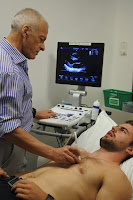Keeping as fit as a fiddle
Progress Health physiotherpist, Sarah Upjohn specialises in helping musicians, provides tips on why we could all benefit from improving our posture
34% of adults and 69% of children in the UK play musical
instruments.[1] The sound of an
orchestra tuning up before performance brings a sense of anticipation and
excitement to any audience. It is the accumulation of hundreds of hours of
practice by the musicians brought together by the skill of the conductor.
Unfortunately, like many professional and keen amateur athletes, this
dedication can result in playing-related musculoskeletal injuries. Young
musicians, professional orchestral musicians and conservatoire students can all
suffer and, at worst, an injury can mean they are prevented from playing
again.
Sarah Upjohn is a specialist
physiotherapist at Progress – The Cambridge Centre for
Health and Performance, and Spire Cambridge Lea Hospital and her particular
expertise is in treating musculoskeletal disorders through the analysis and
re-education of movement and posture. She uses an analytical approach to
successfully treat a wide variety of musculoskeletal disorders.
She believes we should all follow these simple tips and
look after our posture:
1.
Be
mindful of your posture and position as you sit at work
2.
Aim to
maintain symmetry, or return to a position of symmetry.
3.
Let go of accumulating muscle tension, particularly in shoulder girdles
4.
Move from one fixed position (ie sitting at a desk) and do gentle
stretches regularly throughout the day.
Sarah’s specialism outside of her work at Progress is
helping young musicians at the Purcell School for Young Musicians and for BAPAM
(the British Association of Performing Arts Medicine). She has more than nine
years’ of experience of treating instrumental musicians.
She explains:
“In basic terms we are all fully aware repetitive strain can
lead to injury. It is important we understand the risk factors of any activity
we chose to undertake and minimise injury. This is especially true in younger
people who spend hours doing the same exercise or practice. Some sports
have addressed this; for example, rowers have two oars until they are 15 years
old when they can row sweep (one blade) and ballerinas cannot use pointe until
their feet are fully grown. There are no such measures in music and as
musicians often play or practise for between two and seven hours a day, they
are at risk from acquiring playing-related injuries, which, with appropriate
care, are mainly preventable.”
Sarah supplies some tips to keep people playing
longer.
1. Increase
playing time gradually
2. Introduce a new repertoire
gradually
3.
Be aware that
stress can produce tension in muscles, increasing the workload that the muscle
is doing
4.
Remember to
adjust stands and supports as the child grows
5.
Do not add additional stressors immediately after a growth spurt when
children are particularly vulnerable to soft tissue injury
[1] ABSRM, 2014

